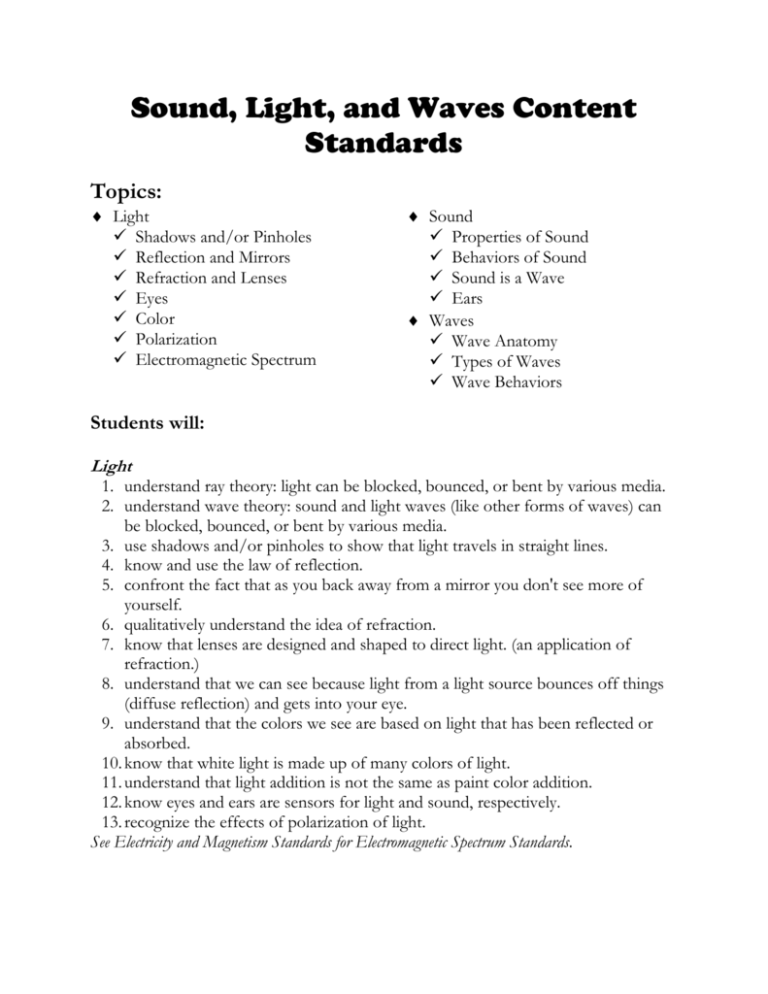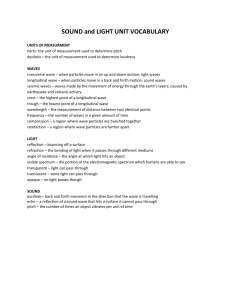Light, Sound and Waves Standards
advertisement

Sound, Light, and Waves Content Standards Topics: Light Shadows and/or Pinholes Reflection and Mirrors Refraction and Lenses Eyes Color Polarization Electromagnetic Spectrum Sound Properties of Sound Behaviors of Sound Sound is a Wave Ears Waves Wave Anatomy Types of Waves Wave Behaviors Students will: Light 1. understand ray theory: light can be blocked, bounced, or bent by various media. 2. understand wave theory: sound and light waves (like other forms of waves) can be blocked, bounced, or bent by various media. 3. use shadows and/or pinholes to show that light travels in straight lines. 4. know and use the law of reflection. 5. confront the fact that as you back away from a mirror you don't see more of yourself. 6. qualitatively understand the idea of refraction. 7. know that lenses are designed and shaped to direct light. (an application of refraction.) 8. understand that we can see because light from a light source bounces off things (diffuse reflection) and gets into your eye. 9. understand that the colors we see are based on light that has been reflected or absorbed. 10. know that white light is made up of many colors of light. 11. understand that light addition is not the same as paint color addition. 12. know eyes and ears are sensors for light and sound, respectively. 13. recognize the effects of polarization of light. See Electricity and Magnetism Standards for Electromagnetic Spectrum Standards. Sound 1. understand that the source of all sound is a vibration 2. know that sound is a longitudinal wave of a medium, with areas of compression and rarefaction. 3. know that sound requires a medium to travel in and that the speed of a sound wave depends on the medium. 4. have a rough idea of the speed of sound in air and in water and will know that sound is slower than light. 5. know that sound vibrations are characterized by frequency (pitch) and amplitude (loudness). 6. know that sound is an example of mechanical energy. 7. qualitatively understand the Doppler effect. 8. know that resonance occurs when the forced vibration is the same as the natural frequency of an object. Waves 1. be able to describe a wave in terms of wavelength, amplitude, frequency, and speed. 2. understand wave theory: sound and light waves (like other forms of waves) can be blocked, bounced, or bent by various media. 3. differentiate between the two forms of waves: longitudinal and transverse. 4. distinguish between mechanical and electromagnetic waves. 5. differentiate between the motion of the wave and the motion of the medium. 6. differentiate between wave motion (simple harmonic nonlinear motion) and the motion of objects (nonharmonic). 7. know that sound is a longitudinal wave and know that visible light is an electromagnetic wave and that it is a transverse wave. 8. give definitions of, graph, and interpret graphs of constructive and destructive interference and understand that waves pass through each other.








